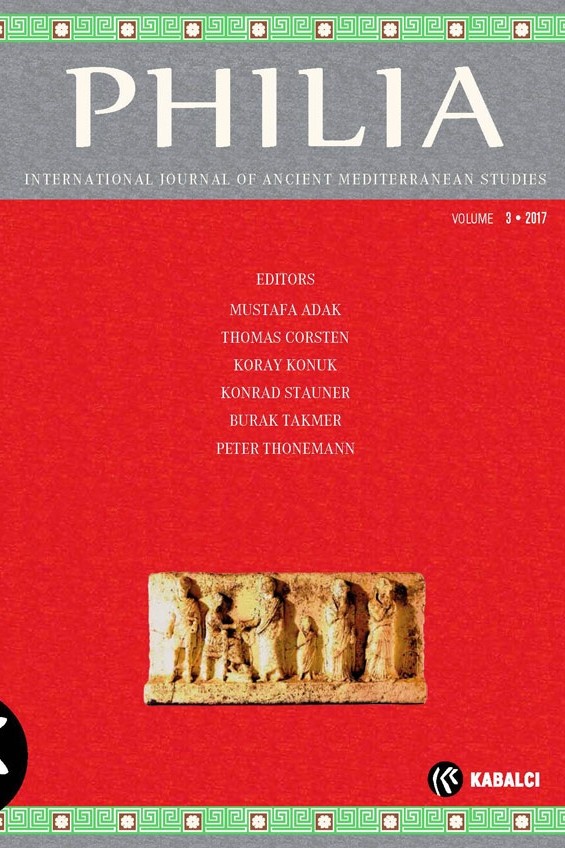Likçe ◊ İşareti Üzerine Bir İlave
Yazar, yayımlanan bir makalesinde Likçe yazı sisteminde elmasa benzeyen, ses karşılığı olmayan ◊ işaretinin işlevini incelemiş ve bu işaretin *-hih > *-hh sonucu ortaya çıkan bir sesi göstermek için meydana getirilmiş olabileceğini önermiştir. Buna ek olarak burada Klasik Dönem Likçe sikkelerde yer alan Pttah lejantına odaklanılmaktadır. Zagaba ve Zẽmuri yerleşimlerinin isimleri sikkelerde toponym’lerin genitivus hali olarak Zagah◊ ve Zẽmuh◊ şeklinde verilmiştir. Ksanthos Agorası’nda yer alan dikme anıtta ise Tlawa ve Xbane yer isimlerinin genitivus’tan üretilmiş akkusativus («accusativi genitivi») halleri Tlahñ ve Xbahñ şeklinde verilmiştir. Bu kıyaslamadan yola çıkarak sikkelerde karşımıza çıkan Pttah sözcüğünün Pttara (Yunanca Patara) yer isminin genitivus hali olması gerektiği önerilmektedir.
Anahtar Kelimeler:
Likya sikkeleri, Likçe dili ve yazı sistemi, Likya toponym’leri ve onların Genitivus halleri, ◊ işareti
Additional Note on the Lycian Sign ◊
In a previous article, the author has suggested that the sign in the shape of a diamond was invented in the Lycian script for a sound that resulted from *-hih > *-hh. In this additional note he analyses the form Pttah which occurs on a recently published coin from early 4th century BC. Pttah is linked with the coin legends Zagah◊ and Zẽmuh◊, genitives of the toponyms Zagaba and Zẽmuri, and with Tlahñ and Xbahñ in the inscription of the pillar at the agora of Xanthos, ‘accusativi genitivi’ of the toponyms Tlawa and Xbane. It is therefore an analogous genitive of Pttara, Greek Patara.
___
- Adiego 2019 I.-X. Adiego, Sobre algunes noves llegendes monetals lícies, in: N. Bolatti Guzzo – P. Taracha (Hgg.), «And I Knew Twelve Languages». A Tribute to M. Poetto on the Occasion of His 70th Birthday, Warschau 2019, 19–17.
- Müseler 2016 W. Müseler, Lykische Münzen in europäischen Privatsammlungen, Istanbul 2016.
- Müseler 2019 W. Müseler, Opponents and successors of the Xanthian dynasty in Western Lycia: The Weχssere questions reconsidered, Gephyra 17, 2019, 27–79.
- Müseler – Schürr 2018 W. Müseler – D. Schürr, Zur Chronologie in den Inschriften auf dem Agora-Pfeiler von Xanthos (TL 44), Klio 100, 2018, 381–406.
- N G. Neumann, Neufunde lykischer Inschriften seit 1901 (Denkschr. ÖAW, phil.-hist. Kl. 135), Wien 1979.
- Schürr 1998 D. Schürr, Kaunos in lykischen Inschriften, in: W. Blümel – P. Frei – Chr. Marek (Hgg.), Colloquium Caricum. Akten der Internationalen Tagung über die karisch-griechische Bilingue von Kaunos 31.10.–1.11.1997 in Feusisberg bei Zürich (= Kadmos 37, 1998), 143–162.
- Schürr 2005 D. Schürr, Das Pire-Poem in Antiphellos, Kadmos 44, 2005, 95–164.
- Schürr 2010 D. Schürr, Lykische Genitive, IF 115, 2010, 118–126.
- Schürr 2014 D. Schürr, Lykische Orte und ihre Namen: Drei Namentypen, in: P. Taracha – M. Kapełuś (Hgg.), Proceedings of the Eighth International Congress of Hittitology, Warsaw, 5–9 September 2011, Warschau 2014, 743–774.
- Schürr 2017 D. Schürr, Zum lykischen Rautenzeichen ◊, Philia 3, 2017, 167–171.
- TL E. Kalinka, Tituli Lyciae lingua Lycia conscripti (Tituli Asiae Minoris I), Wien 1901.
- ISSN: 2149-505X
- Başlangıç: 2015
- Yayıncı: Kabalcı Yayıncılık
Sayıdaki Diğer Makaleler
Likçe ◊ İşareti Üzerine Bir İlave
Parsibey’den (Kuzeydoğu Phrygia) Potamos’a Yeni Bir Adak
Orta Hermos Vadisi’nden Yeni Yazıtlar
Dağlık Kilikya’da Homeros: Lamos’tan Bir Geç Hellenistik Epik Şiir
Mustafa ADAK, Christina KOKKINIA
Yozgat İlinden Yeni Hıristiyan Mezar Yazıtları
Lidce’de Sardis, Spelmos, Kroisos ve λαίλας
Nikomedeia Kenti’nin Agoranomos’ları
Nysa ad Maeandrum’da Heykeltraş Eukharistos’un Adakları
Emanuel ZINGG, Christian MAREK
Kagrai’da İkamet Eden Hermogenes Soyu: Yukarı Melas Vadisi’nde Taşra Eşrafı ve Mikro-Ekonomi
